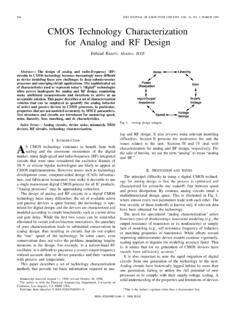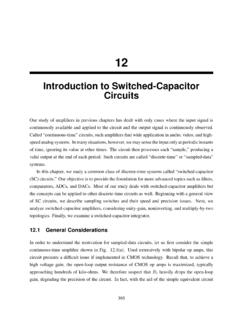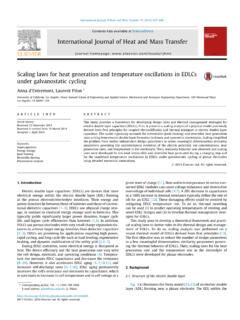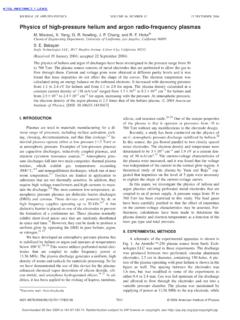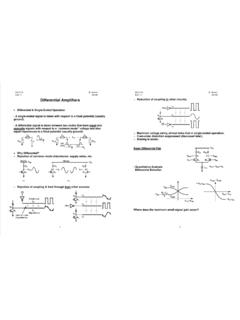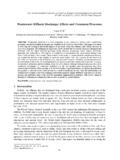Transcription of Fundamentals of Chemical Reactor Theory1
1 1 UNIVERSITY OF CALIFORNIA, LOS ANGELES Civil & Environmental Engineering Department Fundamentals of Chemical Reactor Theory Michael K. Stenstrom Professor Diego Rosso Teaching Assistant Los Angeles, 2003 Introduction In our everyday life we operate Chemical processes , but we generally do not think of them in such a scientific fashion. Examples are running the washing machine or fertilizing our lawn. In order to quantify the efficiency of dirt removal in the washer, or the soil distribution pattern of our fertilizer, we need to know which transformation the chemicals will experience inside a defined volume, and how fast the transformation will be. Chemical kinetics and Reactor engineering are the scientific foundation for the analysis of most environmental engineering processes , both occurring in nature and invented by men. The need to quantify and compare processes led scientists and engineers throughout last century to develop what is now referred as Chemical Reaction Engineering (CRE).
2 Here are presented the basics of the theory and some examples will help understand why this is fundamental in environmental engineering. All keywords are presented in bold font. Reaction Kinetics Reaction Kinetics is the branch of chemistry that quantifies rates of reaction. We postulate that an elementary Chemical reactionI is a Chemical reaction whose rate corresponds to a stoichiometric equation. In symbols: A + B C + D [1] I for our purpose we will limit our discussion to elementary reactions Stenstrom, & Rosso, D. (2003) Fundamentals of Chemical Reactor Theory 2 and the reaction rate will be defined as: -r = k (cA) (cB) where k is referred as the specific reaction rate (constant). The overall order of reaction III is defined as: n = [3] The temperature dependency of k is described by the Arrhenius equation: /()aERTkTA e [4] where, A = preexponential or frequency factor Ea = activation energy [J/mol, cal/mol] R = gas constant = J/mol K = cal/mol K T = absolute temperature [K] The Mass Balance Mass is a conservative entityIV, hence given a control volume V the sum of mass flows entering the system will equal the sum exiting minus (plus) the consumed (generated) or accumulated fractions: rate ofrate ofrate ofrate ofrate ofmassmassmassmassmassinoutgeneratedcons umedaccumulated [5] shortly.
3 IN OUT + PROD CONS = ACC [6] Equation [6] represents the key point in mass transfer: analogously to the force balance in statics, the mass balance allows us to quantify and verify mass flows in our system. Let us now apply this fundamental balance to some ideal examples. Ideal Chemical Reactors A batch Reactor , as its name states, is a non-continuous and perfectly mixed closed vessel where a reaction takes place. Figure 1 shows a schematic drawing of it. II this is the reaction rate with respect to the reactants, the one with respect to the products being -r = +k (cD) (cE) III rigorously, is the order of reaction with respect to reactant A, and with respect to B IV physicists would correct this statement, since energy is the only conservative entity; in all engineering applications, mass will be by far slower than light Stenstrom, & Rosso, D.
4 (2003) Fundamentals of Chemical Reactor Theory 3 Fig. 1. Batch Reactor Given its volume V, and the initial internal concentration c0, the total mass will be M = V c0. In the unit time, the concentration will be able to change only in virtue of a Chemical reaction. The mass balance [6] quantifies this change: IN OUT + PROD CONS = ACC. In this case: inoutVdmQcQcrdVdt [7] where r is the rate of generation (+) or depletion (-). Since the assumption of no flow in or out of the Reactor volume (Q = 0), and constant Reactor volume V, ()dmd c VdcVVrdtdtdt [8] where c = c(t) is the concentration at any time inside the reactorV. Then, dcrdt . [9] The differential equation [9] is the characteristic equation of a batch Reactor . Considering a first-order reaction (r = -k c): dckcdt [10] solving, 0lncktc [11] or 0ktcce . [12] Equation [12] offers a relationship between concentration and time.
5 At any point in time, then, we can know the inner concentration, known the reaction constant and the initial concentration. For a second-order reaction (r = -k c 2), 001cckc t . [13] V Nota Bene: incc ! c, V Stenstrom, & Rosso, D. (2003) Fundamentals of Chemical Reactor Theory 4 This procedure may be repeated for any order of reaction, just substituting the expression for r in the characteristic equation [9]. : The algebraic passages will heretofore be omitted. A Continuous-Stirred Tank Reactor (CSTR) is a well-mixed vessel that operates at steady-state (Qin=Qout=Q). The main assumption in this case is that the concentration of the incoming fluid will become instantaneously equal to the outgoing upon entering the vessel. Fig. 2 explains visually this concept. Fig.
6 2. Continuous-Stirred Tank Reactor A CSTR differs from a batch only in the fact that it is not closed. Thus, the mass flows in and out of the Reactor in eq. [6] will not cancel: ()0inoutVdmQc crdVdt . [14] The mass balance in [14] equals to 0 thanks to the steady state hypothesis (=no accumulation). Solving, 0inoutHccr [15] where H = V/Q = average hydraulic residence time. Eq. [15] represents the characteristic equation for a CSTR. Assuming a first-order reaction, 11outinHcck . [16] A Plug Flow Reactor (PFR) consists in a long, straight pipe in which the reactive fluid transits at steady-state (no accumulation). The main assumptions of this model are that the fluid is completely mixed in any cross-section at any point, but it experiences no axial mixing, contiguous cross-sections cannot exchange mass with each other. Fig. 3 illustrates it. Q, c0Q, ctQ, ct+t Q, c0u t lA Fig.
7 3. Plug Flow Reactor Operating a mass balance on the selected volume V = A l, and assuming steady-state conditions, we obtain 0tttVdmQc QcrdVdt [17] hence, cout, V cin, Q cout, Q Stenstrom, & Rosso, D. (2003) Fundamentals of Chemical Reactor Theory 5 0ttttttQc Qcr V Qc QcrQ t [18] which reduces to 0tttccrt [19] or crt [20] Considering an infinitesimally thin cross-sectional volume, its thickness will reduce to dl, therefore: dcrdt [21] which, again, is the characteristic equation of the plug flow Reactor .
8 Considering a first-order reaction, the concentration equation will be 0ktcce . [22] Segregated Flow Analysis The non-ideality of industrial and natural processes lead engineers to develop corrections to the ideal models, in order to use them with less restrictions. For this reason, it is defined a residence time distribution, which is a function that describes the evolution of the average instantaneous concentration versus the elapsed time. It is very convenient to express the residence time distribution as the normalized function E, 0()E( )()cttct dt [23] which has its total area under the curve equal to unity: 0E( )1tdt [24] Fig. 4 shows the evolution of E vs. time. The E curve is the distribution needed to account for non-ideal flow. Fig. 4. The residence time distribution Stenstrom, & Rosso, D. (2003) Fundamentals of Chemical Reactor Theory 6 Considering the definition of E, the average residence time will become: 0E( )Httdt [25] An useful tool used in this field is the cumulative residence time fraction (or cumulative frequency) curve F, defined as: 000()F( )E( )()itct dtttdtct dt.
9 [26] Equation 26 shows that the F curve at t=ti is defined as the cumulative area under the E curve from zero to ti. This means that F represents the fraction of flow with a residence time ti. Combining [25] and [26]: 10 FHtd [27] which is the highlited area in fig. 5. Note that the boundaries of the integral in [27] must be 0 to 1, since the area under the E curve equals unity. Fig. 5. The cumulative frequency curve The reason why we introduce the use of these functions is to quantify the non-ideality of reactors. A classic example is the evaluation of the average residence time. According to the ideal Reactor theory, = V/Q, where V is the total volume of the Reactor . In case dead zones are present in the vessel, the residence time distribution will not account for them, showing a decreased Reactor volume. Hence, calculated in both ways will give an estimate of the dead zone volume. Fig. 6 illustrates the characteristic curves for various flows.
10 Stenstrom, & Rosso, D. (2003) Fundamentals of Chemical Reactor Theory 7 Fig. 6. Characteristic curves for various flows Principles of Chemical Reaction Engineering The effort to quantify non-ideal departures in Chemical reactors leads to treat two main non-ideal models, the dispersion model, and the CSTR in series model. It belongs to common sense that if we inject a colored tracer into a flowing Reactor , some of the dye will exit before the expected time (shot-circuiting), while some other will reside longer in the Reactor (backmixing). In the case of a plug flow, the dispersion model accounts for axial dispersion D, which is the physical parameter that quantifies axial backmixing and short-circuiting of fluid. In a differential volume of flowing fluid: 22ccDtx [28] analogous to Fick s first law on diffusion. Considering the whole flowing fluid, [28] will be corrected for the fluid motion through the introduction of an advection term: 22cccDutxx [29] which, in its dimentionless form becomes 22cD cctuLzz [30] where, L = Reactor length u = fluid velocity in the Reactor D = dispersion coefficient [cm2/s] Stenstrom, & Rosso, D.
